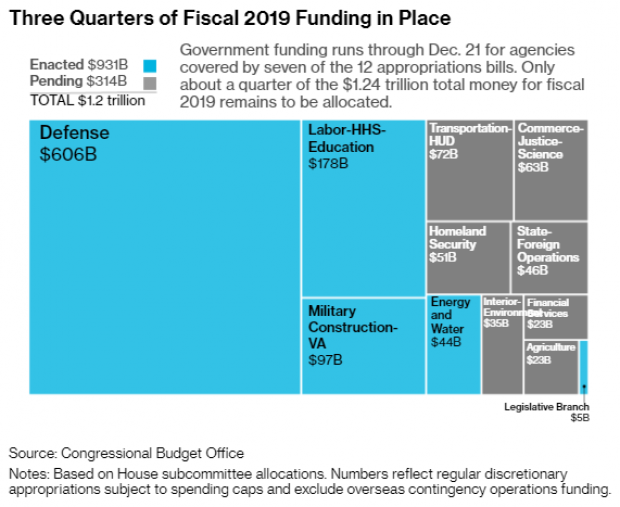Tuesday’s stunningly contentious meeting between President Trump and Democratic leaders Nancy Pelosi and Chuck Schumer did nothing to dissipate the uncertainty over a partial government shutdown at the end of next week.
“I think we’re going to have a shutdown,” Sen. John Kennedy (R-LA) told CNN Wednesday, saying he doesn’t think the president is bluffing and doesn’t think Pelosi will agree to a deal because she doesn’t want to alienate House members whose votes she’ll need on January 3 to win the Speaker’s gavel. And Sen. Richard Shelby (R-AL) told reporters that while a shutdown isn’t inevitable, it’s “more than possible right now.”
Bloomberg’s Jonathan Bernstein, meanwhile, says that a shutdown, especially a prolonged one, is still unlikely, even if Trump really wants it. Democrats have the leverage in this fight since they’ll be taking control of the House on January 3. And many Republican members of Congress won’t want to lose their Christmas break for a “futile, symbolic defeat.”
With nine days to go, here’s a rundown of what’s at stake if the two sides can’t reach a deal.
The government: The impact of a shutdown would be smaller than in past instances, given that Congress and the president have already approved five bills providing fiscal 2019 funding for about three-quarters of the federal government’s operations.
That means fewer agencies would be closed by a shutdown — and, as usual, essential employees at those agencies would still come to work. At the Department of Homeland Security, which has not yet been funded for 2019, “the overwhelming majority of border patrol, emergency management and immigration enforcement staff would be able to keep doing their jobs, though with their pay delayed,” Bloomberg reports. “At the Department of Housing and Human Development, on the other hand, 87 percent of the agency’s 7,800 employees would be sent home.”
Overall, an estimated 400,000 federal employees would work without pay and 350,000 would be furloughed, according to Bloomberg. Employees who work without pay would get compensated retroactively once the government reopens, and furloughed workers have typically gotten retroactive pay as well.
The Congressional Research Service updated its report on the shutdown process and effects earlier this week. It’s a good source for more detail.
The politics: “The politics of a government shutdown are pretty low stakes. Unless it lasts long enough to actually disrupt the economy, nobody is going to care about it 2 years from now,” FiveThirtyEight’s Nate Silver tweeted. “What does matter is whether Trump realizes that focusing solely on his base is a good way to be a 1-term president. So shutting down the government for a quixotic attempt to gain border wall funding would be a bad sign in that regard. But won't matter much unto itself.” Bloomberg’s Bernstein adds, though, that the shutdown battle could have important longer-term consequences that play out in future fights if it affects the public reputations of the leaders involved.
How a shutdown fight could end: Politico’s Playbook outlines how the president and Congress might resolve this fight: Trump folds and lets Congress “pass a stopgap with the current border security funding structure, which he has already touted as being effective. He could probably extract some concessions around the edges to help him sell it to himself and his base. He’ll blame Democrats and he could say he’s going to come back next year with a request for more border money.” If a shutdown happens, Pelosi could pass stopgap funding once the 116th Congress convenes in January. “At that point, it would fly through the Senate and Trump would have to sign it. There are plenty of Democrats and Republicans who think this is the most likely scenario at this moment.”






